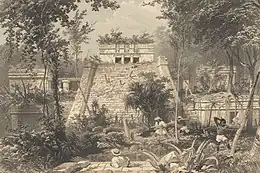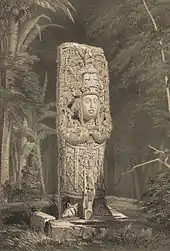Frederick Catherwood | |
|---|---|
 The figure depicted in this lithograph is presumed to be a representation of Catherwood himself.[1] | |
| Born | 27 February 1799 Hoxton, England |
| Died | 27 September 1854 (aged 55) Atlantic Ocean |
| Occupation(s) | Artist and Architect |
Frederick Catherwood (27 February 1799 – 27 September 1854) was an English artist, architect and explorer, best remembered for his meticulously detailed drawings of the ruins of the Maya civilization. He explored Mesoamerica in the mid 19th century with writer John Lloyd Stephens. Their books, Incidents of Travel in Central America, Chiapas and Yucatán and Incidents of Travel in Yucatán, were best sellers and introduced to the Western world the civilization of the ancient Maya. In 1837, Catherwood was elected into the National Academy of Design as an Honorary member.
Mediterranean travels
Catherwood, having made many trips to the Mediterranean between 1824 and 1832[2] to draw the monuments made by the Egyptians, Carthaginians, and Phoenicians, stated that the monuments in the Americas bear no architectural similarity to those in the Old World. Thus, they must have been made by the native people of the area. Catherwood made visits to Greece, Turkey, Egypt, and Palestine and with Joseph Bonomi the Younger made drawings and watercolors of the ancient remains there. During a six-week period in 1833, Catherwood was probably the first Westerner to make a detailed survey of the Dome of the Rock in Jerusalem.[3]
Catherwood developed a reputation as a topographical artist. He perfected a drawing technique which used the camera lucida[4] and supplied the drawings for the panoramas of Jerusalem and Thebes shown by Robert Burford in Leicester Square.[5][6]
Central America

In 1836 he met travel writer John Lloyd Stephens in London. They read the account of the ruins of Copán published by Juan Galindo, and decided to try to visit Central America for themselves and produce a more detailed and better illustrated account. The expedition came together in 1839 and continued through the following year, visiting dozens of ruins and resulting in the detailed description of 44 sites, many for the first time.[4] Stephens and Catherwood are credited for the rediscovery of the Maya civilization, and through their publications brought the Maya back into the minds of the Western World.[7]
The expedition resulted in the book Incidents of Travel in Central America, Chiapas, and Yucatan, published in 1841, with text by Stephens and engravings based on the drawings of Catherwood.
Stephens and Catherwood returned to Yucatan to make further explorations, resulting in Incidents of Travel in Yucatan in 1843.
The following year Catherwood published Views of Ancient Monuments in Central America, Chiapas and Yucatan, with 25 colour lithographs from watercolours he made at various ruins. This folio was published in May 1844 simultaneously in London and New York in an edition of 300. Some 282 copies are known to survive, mostly held in private collections or libraries.
A large number of his original drawings and paintings were destroyed when the building where he was exhibiting them in New York City caught fire, but a number survive in museums and private collections, often showing more detail than the published engravings.
Last years

With the California Gold Rush Catherwood moved to San Francisco, California to open up a store to supply miners and prospectors, which he considered a more likely way to make money than chasing after the gold himself.
In 1854, Frederick Catherwood was a passenger aboard the steamship Arctic, making a crossing of the Atlantic Ocean from Liverpool to New York. On 27 September[8] in conditions of poor visibility, the Arctic collided with the French steamer Vesta, and sank with much loss of life, including Catherwood. Mysteriously Catherwood's name was left off the official casualty lists for weeks until a concerted effort by his friends and colleagues resulted in a belated inclusion of a single line in the New York Herald Tribune, under the listing of "The Saved and the Lost: Mr Catherwood Also is Missing". He was 55 years old.
The question of his portrait

Traditionally, it is thought that the only portrait of Catherwood is in the famous Table XXIV of Views of Ancient Monuments in Central America, Chiapas and Yucatan, with a view of the temple of Tulum. The scholar Fabio Bourbon, after studies and a long reflection, has formulated a different hypothesis. It is well known that during the second expedition in Central America, Stephens and Catherwood were accompanied by a young surgeon (and ornithologist) from Boston, Samuel Cabot III, born in Boston on 20 September 1815. The Cabot family was part of the upper class in Boston. At the time of the trip, he was almost 27 years old. Years later he would become an eminent surgeon and a well known personality in Boston. Samuel III was described as a person rather slender, tall, with light hair and light eyes. There is an image taken by Oliver Wendell Holmes (1809-1894) with members of the Boston Society for Medical Improvement, around 1853. Samuel is seated, third from left. Eleven years had passed since the adventure in Yucatan, but he could very well be the person depicted by Catherwood in the table, holding a measuring tape. Catherwood, in fact, was a pragmatic man, used to documenting the reality with his pencil. Frederick presumably had no interest in representing himself, indeed he never painted his self-portrait.
Notes
- ↑ Detail from Plate 24 ("Temple, at Tuloom") in Catherwood's Views of Ancient Monuments in Central America, Chiapas and Yucatan (1844), lithography in stone by William Parrott after original watercolor by Catherwood. The figure is illustrated taking measurements of the temple at Tulum.
- ↑ von Hagen (1968, p. xiii)
- ↑ "Drawings of Islamic Buildings: Dome of the Rock, Jerusalem". Victoria and Albert Museum. Archived from the original on 9 March 2009.
Until 1833 the Dome of the Rock had not been measured or drawn; according to Victor von Hagen, "no architect had ever sketched its architecture, no antiquarian had traced its interior design…" On 13 November in that year, however, Frederick Catherwood dressed up as an Egyptian officer and accompanied by an Egyptian servant "of great courage and assurance", and entered the buildings of the mosque with his drawing materials … "During six weeks, I continued to investigate every part of the mosque and its precincts." Thus, Catherwood made the first complete survey of the Dome of the Rock, and paved the way for many other artists in subsequent years, such as William Harvey, Ernest Richmond, and Carl Friedrich Heinrich Werner.
- 1 2 Ades, Dawn; Brett, Guy; Catlin, Stanton L.; O'Neill, Rosemary (1989). Art in Latin America: The Modern Era, 1820-1980. New Haven: Yale University Press. ISBN 978-0-300-04556-7. OCLC 20019495.
- ↑ "Exhibitions". The Gentleman's Magazine. 158: 73. July 1835.
- ↑ "A Description of a view of Thebes, now exhibiting at the Panorama, Broadway, corner of Prince and Mercer Streets, New-York". Romantic Circles. Retrieved 6 November 2015.
- ↑ L. Sprague de Camp (2012). Lost Continents. Courier Corporation. p. 105. ISBN 978-0486147925. Retrieved 17 May 2014.
- ↑ See Bourbon (1999); Fox (2003, p. 128). The Arctic left port on 20 September, which is sometimes (erroneously) given as the date of the collision.
References
- Bourbon, Fabio (1999). The Lost Cities of the Mayas: the Life, Art and Discoveries of Frederick Catherwood. Shrewsbury: Swan Hill. ISBN 1-84037-042-4. OCLC 40926474.
- Carlsen, William (2016). Jungle of Stone: The Extraordinary Journey of John L. Stephens and Frederick Catherwood. William Morrow. ISBN 978-0062407399.
- Coe, Michael D. (1992). Breaking the Maya Code. London: Thames & Hudson. ISBN 0-500-05061-9.
- Evans, R. Tripp (2004). Romancing the Stone: Mexican Antiquity in the American Imagination 1820-1915. University of Texas Press. ISBN 0292702477.
- Fox, Stephen R. (2003). Transatlantic: Samuel Cunard, Isambard Brunel, and the Great Atlantic Steamships. New York: HarperCollins. ISBN 0-06-019595-9. OCLC 51306221.
- Harris, Peter (2006). "Cities of Stone: Stephens & Catherwood in Yucatan, 1839-1842". Co-Incidents of Travel in Yucatan. Photoarts Journal (Summer 2006). Archived from the original on 22 October 2008. Retrieved 24 July 2007.
- von Hagen, Victor W. (1968). F. Catherwood: Architect-Explorer of Two Worlds. Barre MT: Barre Publishers. OCLC 512015.
External links
 Media related to Frederick Catherwood at Wikimedia Commons
Media related to Frederick Catherwood at Wikimedia Commons- "Drawing From the Past: Maya Antiquity Through the Eyes of Frederick Catherwood", online exhibition by Smith College Libraries of Catherwood's Views of Ancient Monuments lithographs
- "Frederick Catherwood's Lithographs", online reproductions of a permanent exhibition of his work at the Casa Frederick Catherwood, Mérida, Yucatán
- Reed College website including all the illustrations of Uxmal, Kabah, Sayil, and Labná in Stephens and Catherwood's 1843 Incidents of Travel in Yucatan and in Catherwood's 1844 Views of Ancient Monuments.
- Frederick Catherwood Archival card catalog. Held by the Department of Drawings & Archives, Avery Architectural & Fine Arts Library, Columbia University.
- The Catherwood Project